贵金属基合金制备及其在锂空气电池的应用毕业论文
2020-06-19 21:53:00
摘 要
可充电电池是能源转化和存储领域中的重要分支。作为可充电电池的一种,锂空气电池由于其高理论能量密度而引起了相当大的关注。其能量密度达到11400 Wh kg-1,在目前主要研究和应用的电池体系中是最高的。使用环保且无限的氧气源也使得其成为更有吸引力的下一代储能系统。
本文采用操作简单的溶液中等离子法合成了贵金属基合金,成功制备了碳材料负载的钯钴、金铜合金复合纳米催化材料。通过在贵金属中添加过渡金属,不仅减低了贵金属的使用量,减低了催化剂的成本,还有效地防止了贵金属颗粒聚集。而且由于过渡金属对贵金属的电子有调变效应,其通过改变贵金属原子间的距离、电荷分布和表面组分显著提高了贵金属的ORR活性,还通过增加贵金属表面的粗糙度,增加了贵金属的活性位点,进一步提高了其催化活性。同时由于溶液中等离子法这一合成方法具有的优势,制备得到的催化剂表面清洁度高、催化活性强。将其应用于锂空气电池阴极材料中,表现出了较好的锂空气电池性能,降低了电池充放电过电位,提高了电池的循环稳定性。尤其是使用KB作为负载材料的AuCu合金复合催化剂,在100 mA g-1的电流密度下,以1000 mAh g-1的容量定容充放电,能够稳定循环40次以上,显示出了良好的稳定性。同时,制备得到的金铜合金复合纳米催化材料也显示出了对葡萄糖检测的灵敏性。
关键词:贵金属基合金 锂空气电池 溶液中等离子法 葡萄糖检测
Preparation of Precious Metal Based Alloys and their Application in Lithium Air Batteries
ABSTRACT
Rechargeable batteries are important branches of energy conversion and storage. As a kind of rechargeable batteries, lithium air batteries caused widely attention due to its high theoretical energy density. Their energy density achieves 11400 Wh kg-1, the highest in the current main research and application of the battery system. The use of environmentally friendly and infinite oxygen sources also makes it a more attractive next-generation energy storage system.
In this paper, the palladium-cobalt, gold-copper alloy composite nanocatalysts were successfully synthesized by using a simple method of solution plasma sputtering technique. Noble metals alloying with transition metals can not only reduce the using amount of the noble metals and the cost of the catalysts but also effectively prevents the aggregation of the noble metal particles. Moreover, the transition metals can greatly improve the ORR activity of the noble metals by changing the interatomic distance between atoms of the noble metals, the charge distribution and the surface species due to the modulating effect on the electrons of the noble metals conducted by the transition metals. And further improved catalytic activity is caused by the increased roughness of the noble metals’ surfaces which can form more surface active sites of the the noble metals. At the same time, due to the advantages of the solution plasma sputtering technique, catalysts had high surface cleanliness and strong catalytic activity. Better performance of lithium air batteries such as reduced overpotential of charge/ discharge and improved stability was exhibited by using the synthesized catalysts as cathode materials of lithium air batteries. In particular, batteries using AuCu/KB composite catalysts showed satisfying cyclic stability which was capable of stable cycling for more than 40 cycles with a limited capacity of 1000 mAh g-1 at 100 mA g-1. At the same time, the prepared gold-copper alloy composite nanocatalysts also showed sensitivity to glucose detection.
Key Words:Noble metal based alloy; Li-Air battery; Solution plasma sputtering technique; Glucose detection
目 录
摘 要 I
ABSTRACT II
目 录 I
第一章 绪论 1
1.1 背景介绍 1
1.1.1 锂空气电池概述 1
1.1.2 锂空气电池进展 1
1.1.3 锂空气电池原理 1
1.1.4 锂空气电池存在的问题 2
1.1.5 锂空气电池阴极电催化剂 3
1.2 贵金属基合金电催化剂的制备方法 5
1.2.1 贵金属基合金电催化剂常用制备方法 5
1.2.2 溶液中等离子体法诱导合成贵金属基催化剂 5
1.3 AuCu合金在葡萄糖检测中的应用 6
第二章 实验方案 7
2.1 实验药品 7
2.2 实验仪器 7
2.3 样品制备 8
2.3.1 石墨烯纳米片负载钯钴合金复合催化剂的合成 8
2.3.2 石墨烯纳米片负载金铜合金复合催化剂的合成 8
2.3.3 CNTs负载钯钴合金复合催化剂的合成 9
2.3.4 CNTs负载金铜合金复合催化剂的合成 9
2.3.5 科琴黑负载钯钴合金复合催化剂的合成 9
2.3.6 科琴黑负载金铜合金复合催化剂的合成 9
2.3.7 XC-72负载钯钴合金复合催化剂的合成 9
2.3.8 XC-72负载金铜合金复合催化剂的合成 9
2.4锂空气电池制备 10
2.4.1 锂空气电池正极电极制备 10
2.4.2 锂空气电池的组装 10
2.5 工作电极制备 10
2.6 葡萄糖溶液的配置 11
2.7 样品性能表征 11
2.7.1 样品的物相组成表征 11
2.7.2 锂空气电池性能表征 11
2.7.3 样品葡萄糖检测灵敏性表征 11
第三章 实验结果与分析 12
3.1 XRD检测结果分析 12
3.1.1 PdCo合金复合物XRD检测结果分析 12
3.1.2 AuCu合金复合物XRD检测结果分析 12
3.2 PdCo合金复合物催化剂性能分析 13
3.2.1 PdCo/GNs锂空气电池性能分析-恒流定容充放电测试分析 13
3.2.2 PdCo/GNs锂空气电池性能分析-恒流定压充放电测试分析 14
3.2.3 PdCo/KB锂空气电池性能分析-恒流定压充放电测试分析 15
3.2.4 PdCo/KB锂空气电池性能分析-恒流定容充放电测试分析 16
3.3 AuCu合金复合物催化剂性能分析 17
3.3.1 AuCu/GNs锂空气电池性能分析-恒流定压充放电测试分析 17
3.3.2 AuCu/GNs锂空气电池性能分析-恒流定容充放电测试分析 17
3.3.3 AuCu/KB锂空气电池性能分析-恒流定压充放电测试分析 18
3.3.4 AuCu/KB锂空气电池性能分析-恒流定容充放电测试分析 18
3.3.5 AuCu合金葡萄糖检测结果分析 19
第四章 总结与展望 21
4.1 总结 21
4.2 展望 21
参考文献 23
致谢 26
第一章 绪论
1.1 背景介绍
1.1.1 锂空气电池概述
可充电电池可应用于能源转化和存储领域。电池应具备高能量、功率密度,良好循环性能等特性,以此来满足电动汽车高续航力,加速度,低廉价格的要求。除了电动汽车,可充电电池也广泛应用于电力便携式电子设备,并应用于电网级能量存储。与电子和可再生能源技术的快速发展相反,可充电电池的进展相对较慢,因此造成许多应用的瓶颈[1]。在非气态单质元素中,Li的密度是最低的。由于Li 水和热最大,反应放热最多,反应趋势最大,因此Li有最低的电极电势,Li还有非常高的容量,可以达到3860 mAh g-1。作为新兴环保可再充电电池,锂离子二次电池具有诸多优点。它不仅广泛应用于电子产品、小型电动工具、航空航天仪器及相关行业,也是电动汽车的备用电源之一,引起了全球范围内广泛的关注。但其最大容量的达到受到插层结构的限制,目前的锂离子电池正极材料电化学容量仅200 mAh g-1左右。因此,大量的研究工作一直致力于寻找一种能够超越最先进锂离子电池的新型储能系统。作为这样的候选者之一,锂空气(Li-air)电池由于其高理论能量密度而引起了相当大的关注。理论上基于金属锂计算其能量密度,可达到 11400 Wh kg-1 [2]。这一数值在当下已经得到研究和运用的电池体系中是最大的。锂空气电池是一种环保的二次电池,使用环保且无限的氧气源也使得其成为更有吸引力的下一代储能系统。
1.1.2 锂空气电池进展
相关图片展示:
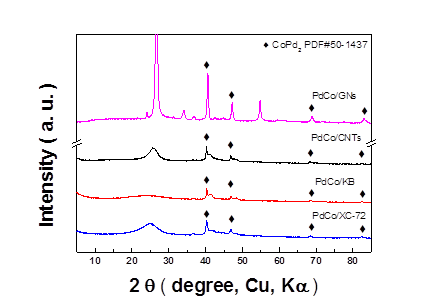
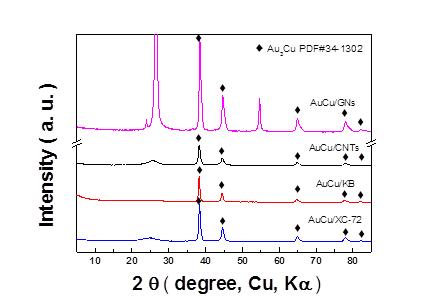
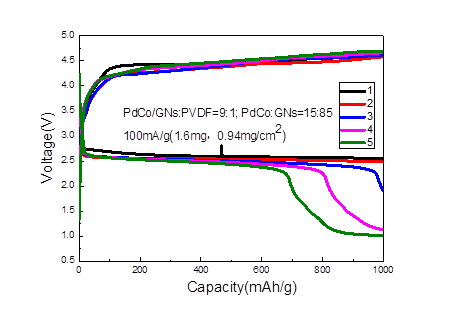
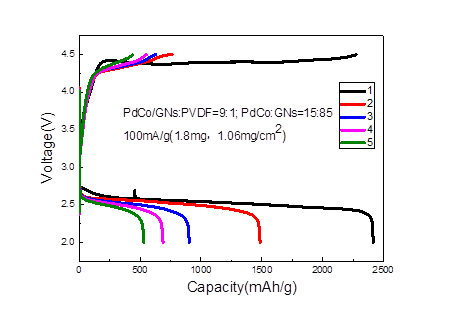
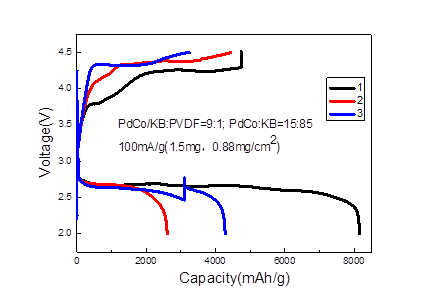
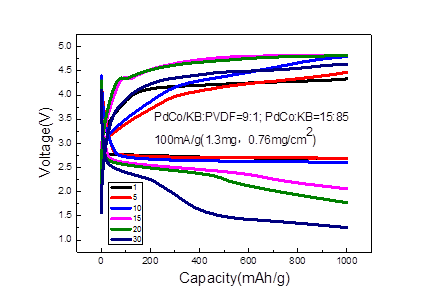
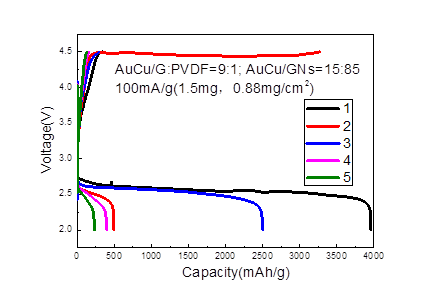
您可能感兴趣的文章
- 蒸养纤维掺杂高铁低钙水泥混凝土的抗海水冲磨性能研究文献综述
- TIPA对水泥-锂渣体系力学性能和水化性能的影响外文翻译资料
- TEA对锂渣-水泥复合粘结剂流变性能及水化性能的影响外文翻译资料
- 硫酸铝无碱液体促进剂的效果研究烷醇胺对硅酸盐水泥水化过程的影响外文翻译资料
- 新型C-A-S-H/PCE纳米复合材料:设计表征和对水泥水化的影响外文翻译资料
- 工业中碳捕获技术以及以水泥回转窑作为核心的吸附再生器外文翻译资料
- Ca/Al层状双氢氧化物的制备及其结构对水泥早期强度的影响外文翻译资料
- 蒸汽养护后混凝土养护方法对混凝土机械强度和透气性的影响外文翻译资料
- 含白云石或石灰石的偏高岭土水泥在相组成与抗压强度的异同外文翻译资料
- 与硅质铁尾矿结合的混凝土的耐久性外文翻译资料




